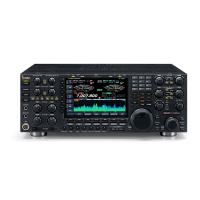15-3
D Receiver
•Receive system : Double conversion superheterodyne system
•Intermediate frequencies :
1st 64.455 MHz (MAIN band)
64.555 MHz (SUB band)
2nd 36 kHz
•Sensitivity :
SSB, CW, RTTY (BW=2.4 kHz, 10 dB S/N)
0.100–1.799MHz 0.5µV(pre-amp 1 ON)
1.800–29.990MHz 0.16µV(pre-amp 1 ON)
50.000–54.000MHz 0.13µV(pre-amp 2 ON)
AM (BW=6 kHz, 10 dB S/N)
0.100–1.799MHz 6.3µV(pre-amp 1 ON)
1.800–29.990MHz 2µV(pre-amp 1 ON)
50.000–54.000MHz 1µV(pre-amp 2 ON)
FM (BW=15 kHz, 12 dB SINAD)
28.000–29.990MHz 0.5µV(pre-amp 1 ON)
50.000–54.000MHz 0.32µV(pre-amp 2 ON)
• Selectivity :
SSB, RTTY (BW=2.4 kHz) More than 2.4 kHz/–3 dB
Less than 3.6 kHz/–60 dB
CW (BW=500 Hz) More than 500 Hz/–3 dB
Less than 700 Hz/–60 dB
AM (BW=6 kHz) More than 6.0 kHz/–3 dB
Less than 15.0 kHz/–60 dB
FM (BW=15 kHz) More than 12.0 kHz/–6 dB
Less than 20.0 kHz/–60 dB
• Spurious and image rejection ratio : More than 70 dB (except IF through on 50 MHz band)
• Squelch sensitivity :
SSB,CW,RTTY,PSK31 Lessthan5.6µV
FM Lessthan1µV
• RIT variable range : ±9.999 kHz
• Audio output power : More than 2.6 W at 10% distortion with an 8 Ω load
• PHONES connector : 3-conductor 6.35 (d) mm (
1
⁄4″)
• EXT-SP connectors : 2-conductor 3.5 (d) mm (
1
⁄8″)/8 Ω×2 (for main and sub)
D Antenna tuner
• Matching impedance range : 16.7 to 150 Ω unbalanced (HFbands;VSWRbetterthan3:1)
20 to 125 Ω unbalanced (50MHzband;VSWRbetterthan2.5:1)
• Minimum operating input : 8 W (HF bands)
15 W (50 MHz band)
• Tuning accuracy : VSWR1.5:1orless
• Insertion loss (after tuning) : Less than 1.0 dB
15
SPECIFICATIONS AND OPTIONS
* The LCD display may have cosmetic imperfections that appear as small or dark spots. This is not a malfunction
or defect, but a normal characteristic of LCD displays.
Spurious signals may be received near the following frequencies. These are made in the internal circuit and does
not indicate a transceiver malfunction.
•0.150MHz•10.490MHz
Spurious waveforms may be displayed on the spectrum scope screen regardless of the transceiver’s condition
(Tx or Rx). They are made in the scope circuit. This does not indicate a transceiver malfunction.
All stated specifications are typical and subject to change without notice or obligation.

